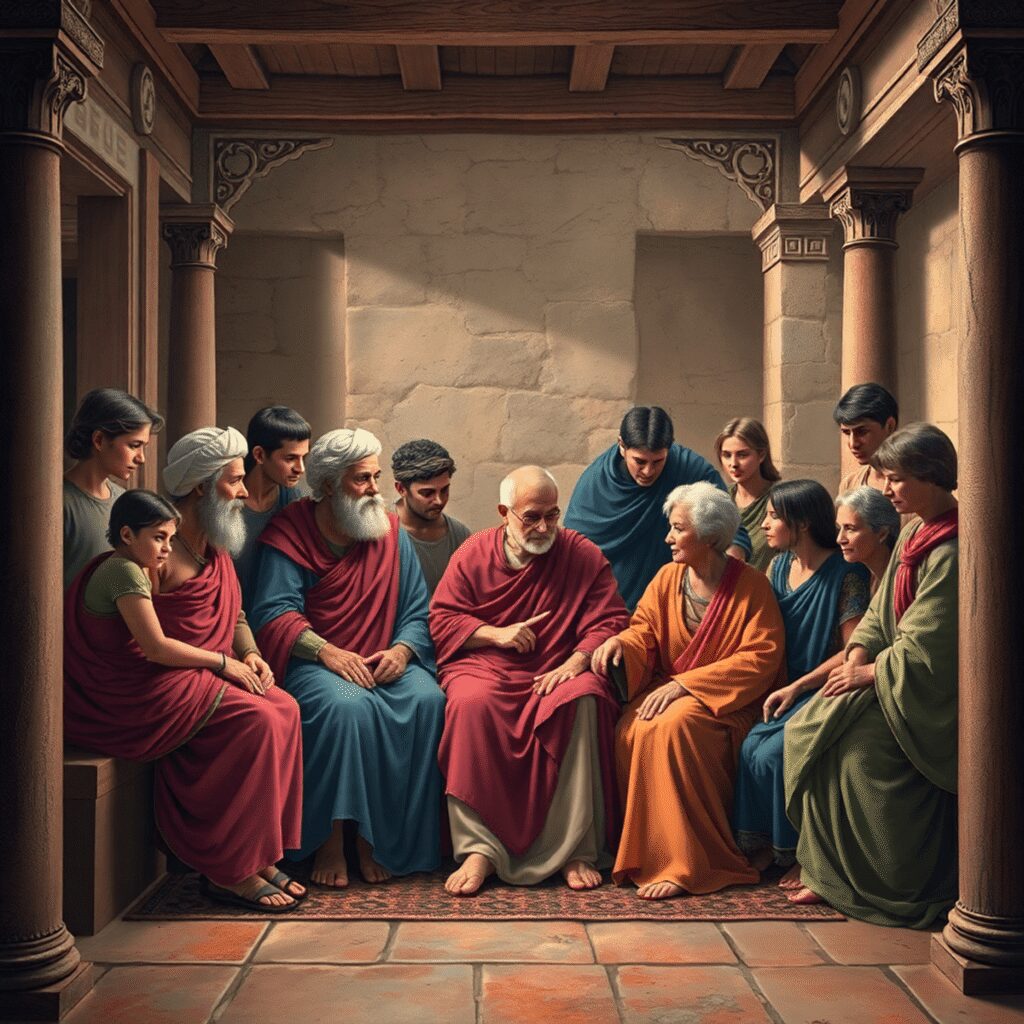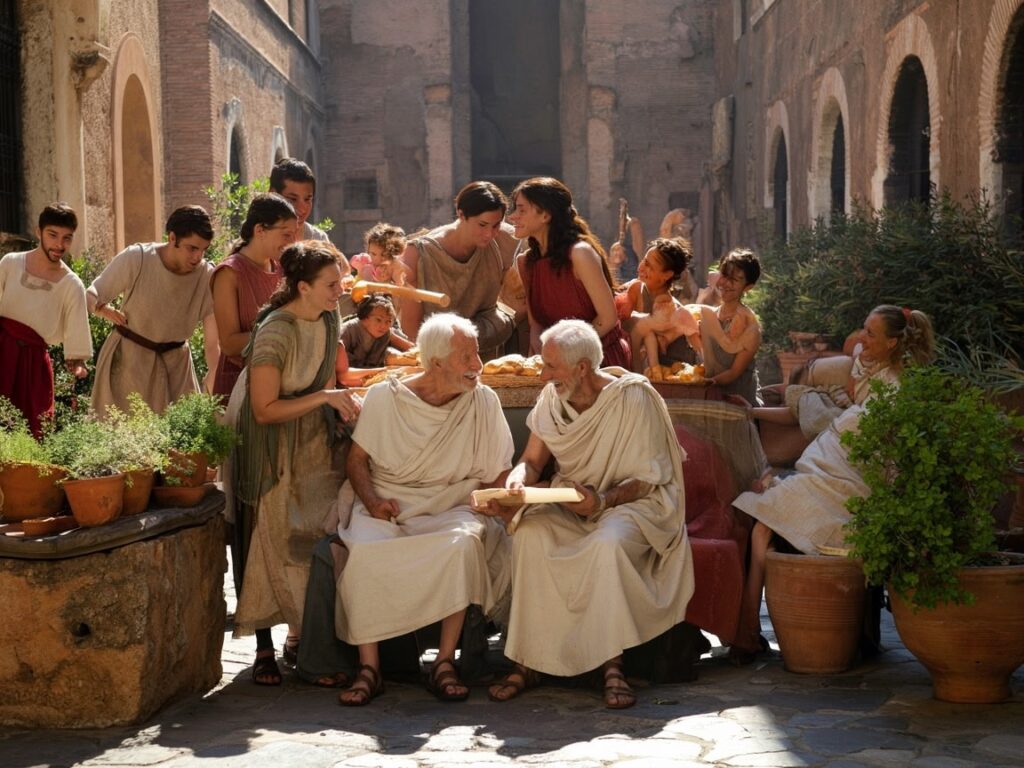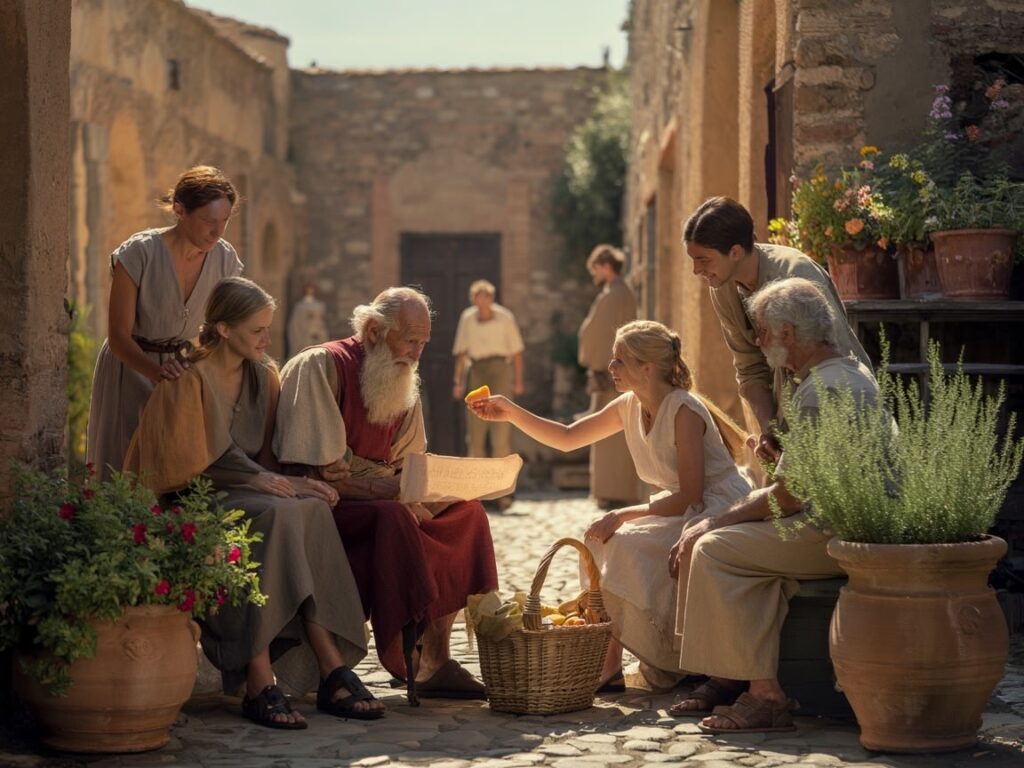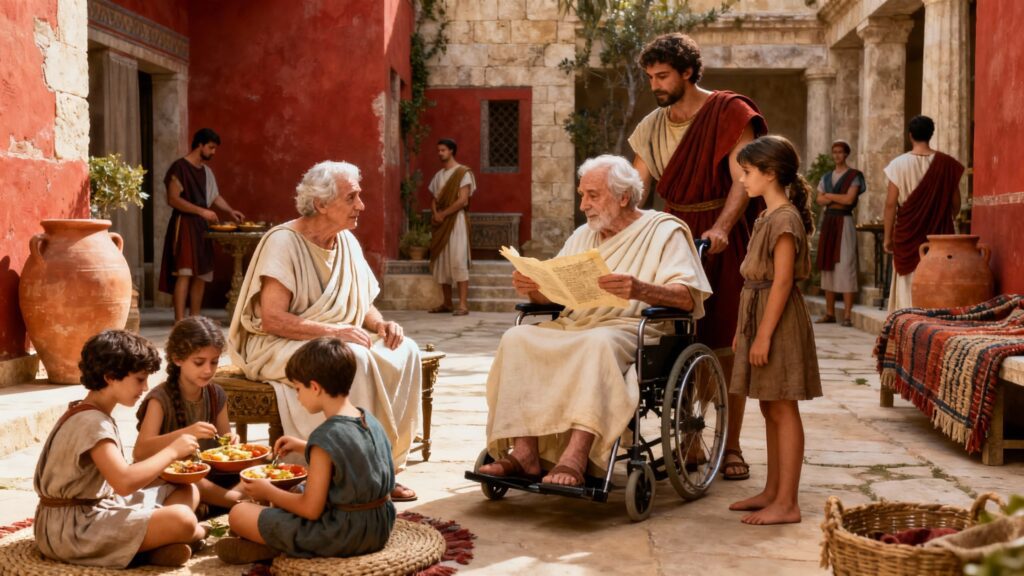Aging is a universal experience that brings unique challenges, especially in the context of elder care. Understanding how ancient Romans dealt with aging parents offers valuable insights into the roots of family responsibility and societal expectations around caring for the elderly.
This article explores elder care comparison between ancient Roman practices and today’s systems, highlighting key differences:
- Family-Centered Care: Ancient Romans relied heavily on multigenerational households, where adult children were morally obligated to care for aging parents.
- Absence of Institutional Support: Unlike modern societies with nursing homes and professional healthcare, Roman elder care lacked formal government or institutional assistance.
- Social and Cultural Attitudes: Respect for elders was deeply ingrained in Roman culture, influencing caregiving roles within families.
Examining these contrasts helps you appreciate how elder care has evolved and what lessons history can teach us about balancing family duties and societal support.
Life Expectancy and Social Perceptions of Aging in Ancient Rome
Average Life Expectancy
In ancient Rome, the average life expectancy was influenced by various factors such as high infant mortality rates. Despite this, many individuals did reach their 60s and 70s.
Definition of Old Age
Older men were typically considered to enter old age around 60, while for women it was around 50. This marked a shift from physical labor to more social and intellectual responsibilities.
Transition in Roles
Elderly Romans moved from roles involving physical labor to those focused on intellectual pursuits and social engagements. They often contributed wisdom and experience to society.
By understanding the average life expectancy in ancient Rome and the societal perceptions of aging, we gain insight into how individuals were valued based on their age and contributions. The transition from physical labor to more intellectual roles highlights the changing dynamics within Roman society as individuals aged.

Filial Piety, Family Responsibility, and Multigenerational Households in Roman Elder Care
The concept of filial piety was central to Roman family life. Adult children bore a strong moral and social obligation to care for their aging parents. This sense of duty was more than personal affection; neglecting an elderly parent was seen as a serious breach of family honor and could even lead to legal consequences. Filial piety shaped daily interactions and the distribution of resources within Roman families.
Roman elder care revolved around the family unit, often structured as multigenerational households. These homes included grandparents, parents, children, and sometimes extended relatives all living under one roof or within close proximity. The presence of multiple generations facilitated comprehensive care—elderly family members received assistance with daily tasks, companionship, and emotional support.
Key features of multigenerational households in elder care:
- Shared responsibilities: Younger family members contributed to physical care and financial support.
- Integration of elders: Older adults maintained active roles in decision-making and social life within the household.
- Support networks: Servants or slaves supplemented family care in wealthier households.
This family-based model contrasted sharply with modern institutional approaches but provided a deeply embedded social framework where care for elders was a collective responsibility, intertwined with respect and familial loyalty.
Medical Understanding, Age-Related Ailments, and Prevention Strategies for the Elderly in Ancient Rome
The elderly population in ancient Rome faced various health challenges, much like today. Common age-related ailments included arthritis, a condition causing joint pain and stiffness, and sensory decline, which affected vision and hearing abilities. The Romans had their own methods of dealing with these issues, drawing from their knowledge of medicine and lifestyle practices.
Common Health Issues Faced by Elderly Romans
- Arthritis: This condition was prevalent among the elderly, causing discomfort and limiting mobility.
- Sensory Decline: Many older Romans experienced a gradual loss of sight and hearing, impacting their daily activities.
Roman Approaches to Managing Aging
The Romans believed in a holistic approach to aging, focusing on various aspects of life to promote well-being. Here are some strategies they employed:
- Diet: A balanced diet rich in fruits, vegetables, whole grains, and lean proteins was emphasized to maintain overall health.
- Exercise: Regular physical activity such as walking, swimming, or engaging in sports helped keep the body active and flexible.
- Rest: Adequate sleep and relaxation were considered essential for rejuvenating the mind and body.
- Intellectual Activities: Engaging in mental exercises like reading, writing, or participating in discussions stimulated cognitive functions.
These practices reflect the Romans’ understanding of the importance of lifestyle factors in managing age-related ailments. While some may find similarities with modern approaches to elder care, it’s interesting to explore how cultural beliefs and available resources influenced their methods.

Gender Differences in Aging, Elder Care Roles, and Support Systems for Women in Ancient Rome
The experience of aging for elderly women in Rome differed significantly from that of their male counterparts. Roman society was deeply influenced by patriarchal norms, which shaped the social status and support available to older women. Unlike elderly men, who often retained influence through family or political roles, older women faced increasing social marginalization as they aged.
Key aspects of this dynamic include:
- Reduced social visibility: Older women were often confined to the domestic sphere, with less opportunity to participate in public life or decision-making. Their value was frequently tied to youth and reproductive ability, causing diminished respect as they grew older.
- Dependence on family: Widowed women especially relied heavily on their children for financial and emotional support. Without a husband’s protection or property rights, many elderly women became vulnerable within their households.
- Limited formal power: While men could pass down political authority or maintain leadership roles despite age, elder women rarely held formal positions of power or influence. Their care and status depended largely on family dynamics rather than societal recognition.
The patriarchal framework thus created distinct challenges for aging women in Rome, shaping not only their personal experiences but also the structure of elder care within families. This gendered disparity contrasts with the more politically active roles elderly men maintained, setting the stage for understanding how aging intersected with authority and civic participation.
Political Influence, Authority Challenges, and the Role of Age in Civic Duties within Roman Society
In ancient Rome, the elderly had a significant political role, especially among the aristocracy. Elders in this class maintained their influence even into old age. Aging aristocrats often held important positions in the Senate and other governing bodies, using their accumulated wisdom and experience to shape policy and social norms. With age came a certain level of prestige that translated into continued respect and authority both in politics and within families.
The Role of Elderly Aristocrats
Elderly aristocrats typically retained seats in the Senate, where their counsel was valued. They were often exempt from physically demanding duties but remained active in decision-making. Additionally, their long tenure allowed them to mentor younger politicians and influence succession.
Conflicts with Younger Generations
Conflicts arose with younger family members who were eager to assert their own power or challenge traditional authority. These challenges sometimes led to internal family struggles over leadership roles and control of estates. The tension between generations reflected broader societal shifts as emerging elites sought to redefine political landscapes. Despite these pressures, respect for the experience of elders often prevented outright confrontations.
Balancing Tradition and Renewal
Roman society found a balance between reverence for elderly aristocrats and acknowledgment of new ambitions from younger relatives. This dynamic shaped governance by blending tradition with gradual renewal, impacting how civic duties were distributed across different age groups.

Modern Perspectives on Elder Care: Institutionalization vs. Family Support Systems
Modern elder care systems offer a variety of options designed to meet the diverse needs of aging populations. These include:
- Nursing homes and assisted living facilities providing 24/7 medical supervision and assistance with daily activities.
- In-home professional healthcare services such as visiting nurses, physical therapists, and home aides.
- Adult day care centers offering social interaction and activities alongside medical support during daytime hours.
- Community and government programs aimed at supporting seniors with meals, transportation, and social services.
These institutionalized approaches contrast sharply with how Ancient Romans dealt with aging parents. In ancient Rome, elder care was overwhelmingly a family-centered responsibility, embedded within multigenerational households. There was no organized government or public welfare system to assist elderly citizens. Caregiving duties fell primarily on adult children, reinforced by strong moral expectations of filial piety.
This reliance on family meant the quality of elder care varied widely depending on family resources and dynamics. Wealthier Roman families could supplement care through servants and slaves, while poorer families relied solely on kinship bonds.
Modern systems reflect societal shifts toward professionalization and specialization in elder care, aiming to relieve families from sole responsibility. However, this can sometimes result in challenges related to emotional connection or cultural expectations that remain rooted in family-based caregiving traditions.
The comparison highlights significant differences between institutionalized support structures today and the intimate, family-driven model that shaped Roman elder care practices.
Emotional Needs, Companionship Aspects, and Societal Attitudes Towards Aging Parents Then and Now
Ancient Rome: Family-Centered Elder Care
In ancient Rome, companionship elder care was deeply embedded in the fabric of multigenerational households. Elderly family members lived alongside children, grandchildren, and extended relatives. This close proximity fostered daily interaction and emotional support. The presence of younger family members offered not only physical assistance but also a vital social connection that helped prevent isolation. Respect and affection were key elements in how Romans cared for their aging parents, reflecting societal values that honored elders as sources of wisdom and tradition.
Informal Emotional Support
Emotional needs were met informally through family bonds rather than specialized services. Conversations, shared meals, storytelling, and participation in household rituals contributed to a sense of belonging and mental engagement for the elderly. The role of servants or slaves in wealthier homes sometimes extended to providing companionship, although this was secondary to familial relationships.
Modern Times: Institutionalized Elder Care
Today’s elder care often addresses emotional needs through formal caregiving structures like nursing homes, assisted living facilities, and professional home care providers. These environments offer social activities designed to combat loneliness and promote mental health but may lack the intimate daily contact found in family-centered settings. Emotional support can come from trained staff and organized group interactions rather than exclusively from kin.
Comparing Approaches: Family vs. Institution
Comparing these approaches highlights a shift from emotionally integrated family networks toward institutionalized models where companionship is structured but less personalized. Understanding this contrast encourages reflection on how modern elder care might better incorporate the meaningful connections that characterized Roman practices.
This shift towards institutionalization raises questions about the effectiveness of current elder care models in meeting emotional needs. A study published in the journal Healthcare emphasizes the importance of addressing these emotional aspects in elder care. On the other hand, research suggests that family-centered care models could provide more holistic support for aging parents by integrating emotional companionship with physical care.

Lessons from Ancient Rome: Balancing Family Responsibility with Evolving Societal Support for Aging Populations
Looking at historical perspectives on elder care can teach us a lot about how family responsibility and respect for elders used to be the main ways to support aging individuals. The Roman model emphasized:
- Moral obligation: Adult children were expected to care for aging parents, blending duty with affection.
- Multigenerational living: Household structures naturally fostered daily companionship and practical assistance.
- Social consequences: Neglect was socially condemned, reinforcing the importance of elder care within the family.
Today, elder care has shifted towards formal institutions and professional services due to changes in society and the workforce. However, we can still learn from the Romans’ focus on respect and personal connection. Families today can use these values to improve emotional well-being alongside medical care.
The evolution of elder care shows a balance between individual family roles and broader societal support systems. Understanding How Ancient Romans Dealt with Aging Parents—Comparisons with Today’s Elder Care encourages a holistic approach that honors tradition while embracing modern solutions.

